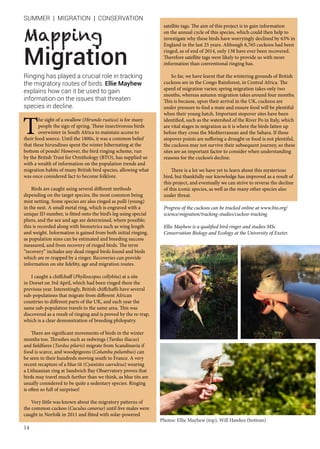
How Bird Ringing Reveals Migration Routes and Threats
- 1. Ringing has played a crucial role in tracking the migratory routes of birds. Ellie Mayhew explains how can it be used to gain information on the issues that threaten species in decline. T he sight of a swallow (Hirundo rustica) is for many people the sign of spring. These insectivorous birds overwinter in South Africa to maintain access to their food source. Until the 1800s, it was a common belief that these hirundines spent the winter hibernating at the bottom of ponds! However, the bird ringing scheme, run by the British Trust for Ornithology (BTO), has supplied us with a wealth of information on the population trends and migration habits of many British bird species, allowing what was once considered fact to become folklore. Birds are caught using several different methods depending on the target species, the most common being mist netting. Some species are also ringed as pulli (young) in the nest. A small metal ring, which is engraved with a unique ID number, is fitted onto the bird’s leg using special pliers, and the sex and age are determined, where possible; this is recorded along with biometrics such as wing length and weight. Information is gained from both initial ringing, as population sizes can be estimated and breeding success measured, and from recovery of ringed birds. The term “recovery” includes any dead ringed birds found and birds which are re-trapped by a ringer. Recoveries can provide information on site fidelity, age and migration routes. I caught a chiffchaff (Phylloscopus collybita) at a site in Dorset on 3rd April, which had been ringed there the previous year. Interestingly, British chiffchaffs have several sub-populations that migrate from different African countries to different parts of the UK, and each year the same sub-population travels to the same area. This was discovered as a result of ringing and is proved by the re-trap, which is a clear demonstration of breeding philopatry. There are significant movements of birds in the winter months too. Thrushes such as redwings (Turdus iliacus) and fieldfares (Turdus pilaris) migrate from Scandinavia if food is scarce, and woodpigeons (Columba palumbus) can be seen in their hundreds moving south to France. A very recent recapture of a blue tit (Cyanistes caeruleus) wearing a Lithuanian ring at Sandwich Bay Observatory proves that birds may travel much further than we think, as blue tits are usually considered to be quite a sedentary species. Ringing is often so full of surprises! Very little was known about the migratory patterns of the common cuckoo (Cuculus canorus) until five males were caught in Norfolk in 2011 and fitted with solar-powered satellite tags. The aim of this project is to gain information on the annual cycle of this species, which could then help to investigate why these birds have worryingly declined by 63% in England in the last 25 years. Although 6,765 cuckoos had been ringed, as of end of 2014, only 138 have ever been recovered. Therefore satellite tags were likely to provide us with more information than conventional ringing has. So far, we have learnt that the wintering grounds of British cuckoos are in the Congo Rainforest, in Central Africa. The speed of migration varies; spring migration takes only two months, whereas autumn migration takes around four months. This is because, upon their arrival in the UK, cuckoos are under pressure to find a mate and ensure food will be plentiful when their young hatch. Important stopover sites have been identified, such as the watershed of the River Po in Italy, which are vital stages in migration as it is where the birds fatten up before they cross the Mediterranean and the Sahara. If these stopover points are suffering a drought or food is not plentiful, the cuckoos may not survive their subsequent journey, so these sites are an important factor to consider when understanding reasons for the cuckoo’s decline. There is a lot we have yet to learn about this mysterious bird, but thankfully our knowledge has improved as a result of this project, and eventually we can strive to reverse the decline of this iconic species, as well as the many other species also under threat. Progress of the cuckoos can be tracked online at www.bto.org/ science/migration/tracking-studies/cuckoo-tracking Ellie Mayhew is a qualified bird ringer and studies MSc Conservation Biology and Ecology at the University of Exeter. Mapping Migration 14 SUMMER | MIGRATION | CONSERVATION Photos: Ellie Mayhew (top), Will Hawkes (bottom)